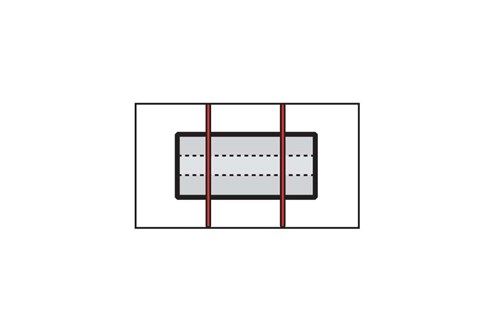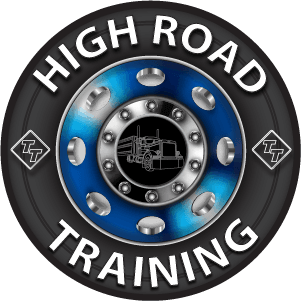CDL Practice Tests: Dominate The CDL Exam!
Choose A Section:
Go!What should you check for when checking the landing gear on the trailer?
- Make sure the crank handle is secured and the support frame is not damaged
- All of these are correct
- Make sure there are no missing parts
- Check that the landing gear is fully raised
When should the air compressor start and stop pumping?
- It should start at about 150 psi and stop at about 200 psi.
- It should start at about 50 psi and stop at about 75 psi.
- It should start at about 100 psi and stop at about 125 psi.
- None of these are correct
Check Air Compressor Governor Cut-in and Cut-out Pressures. Pumping by the air compressor should start at about 100 psi and stop at about 125 psi. (Check manufacturer's specifications.) Run the engine at a fast idle. The air governor should cut out the air compressor at about the manufacturer's specified pressure. The air pressure shown by your gauge(s) will stop rising. With the engine idling, step on and off the brake to reduce the air tank pressure. The compressor should cut in at about the manufacturer's specified cut-in pressure. The pressure should begin to rise.
Option #3 for securing metal coils transported with eyes lengthwise includes all of the following except:
- Attaching at least one tiedown over the top of the coil near the rear of the coil.
- Attaching at least one tiedown over the top of the coil near the front of the coil.
- Using blocking or friction mats to prevent forward movement.
- Attaching at least two tiedowns through the center of the coil.
Tiedowns, Single Coil Option #3
Option #3 is the same as Options #1 and #2, except that the two tiedowns that attach through the eye of the coil are replaced with two tiedowns that pass over the front and the rear of the coil.

Attach at least one tiedown over the top of the coil near the front of the coil.
Attach at least one tiedown over the top of the coil near the rear of the coil.
Use blocking or friction mats to prevent forward movement.
What can be the result of too much weight on the back of the trailer?
- The steer tires won't grip properly
- The steering will feel "heavy" and sluggish
- A "pendulum effect" causing the rear of the trailer to sway back and forth while driving down the highway or jackknife going around a curve
- You won't be able to fuel up properly without being overweight
If you lose your brakes going down a steep grade, which of the following is true:
- Use an escape ramp if it is available. If you do not use it, your chances of having a serious crash may be much greater.
- Steering gently back and forth will create additional friction which will slow the vehicle surprisingly fast, even without brakes.
- Do not use an escape ramp if at all possible. This is an outdated method of stopping. If you try to ride it out on the highway, your chances of surviving are better.
- If your foot brake fades to failure, use the trailer hand brake. This will normally still work in an emergency
Brake Failure on Downgrades. Going slow enough and braking properly will almost always prevent brake failure on long downgrades. Once the brakes have failed, however, you are going to have to look outside your vehicle for something to stop it.
Your best hope is an escape ramp. If there is one, there will be signs telling you about it. Use it. Ramps are usually located a few miles from the top of the downgrade. Every year, hundreds of drivers avoid injury to themselves or damage to their vehicles by using escape ramps. Some escape ramps use soft gravel that resists the motion of the vehicle and brings it to a stop. Others turn uphill, using the hill to stop the vehicle and soft gravel to hold it in place.
Any driver who loses brakes going downhill should use an escape ramp if it is available. If you do not use it, your chances of having a serious crash may be much greater.
Banding is:
- Material used to fill a void between articles of cargo and the structure of the vehicle that has sufficient strength to prevent movement of the articles of cargo.
- A combination of securing devices which form an assembly that attaches cargo to, or restrains cargo on, a vehicle or trailer, and is attached to anchor point(s).
- A strip of material that may be used to unitize articles and is tensioned and clamped or crimped back upon itself. (same as "Strapping")
- A device placed on the exposed edge of an article to distribute tiedown forces over a larger area of cargo than the tiedown itself, to protect the tie-down and/or cargo from damage, and to allow the tiedown to slide freely when being tensioned.
Banding:
A strip of material that may be used to unitize articles and is tensioned and clamped or crimped back upon itself. (same as "Strapping")
Which of the following are true about the pressure relief valve in an air brake system?
- Is normally set to open at 150 psi
- Protects the tank and the rest of the system from too much pressure.
- If it releases air, something is wrong. Have the fault fixed by a mechanic.
- All these are correct
Perception Distance + Reaction Distance + Braking Distance =
- Total slowing distance
- Total Stopping Distance
- Braking resistance
- Total momentum
Perception Distance + Reaction Distance + Braking Distance = Total Stopping Distance
Total Stopping Distance. The total minimum distance your vehicle has traveled, in ideal conditions, with everything considered (including perception distance, reaction distance, and braking distance) until you can bring your vehicle to a complete stop. At 55 mph, your vehicle will travel a minimum of 419 feet.
Before starting down a grade, which of the following is NOT true about your "safe speed?"
- When speed has been reduced to 5 mph below the “safe” speed, release the brakes. (This application should last for about three seconds.)
- Your safe speed will be approximately 5 mph below the maximum speed you can safely descend the grade
- Once a “safe” speed has been reached, apply the brake hard enough to feel a definite slowdown.
- Select a “safe” speed, one that is not too fast for the weight of the vehicle, length and steepness of the grade, weather, and road conditions.
Before Starting Down the Grade. Downshift as needed to help control engine speed and test brakes by gently applying the foot brake to ensure they are functioning properly. As your vehicle moves down the grade, continue checking traffic in all directions, stay in the right-most or curb lane, and, if legal to do so, use the four-way flashers if your vehicle is moving too slowly for traffic. Increase following distance and observe the following downhill braking procedures:
- Select a “safe” speed, one that is not too fast for the weight of the vehicle, length and steepness of the grade, weather, and road conditions.
- Once a “safe” speed has been reached, apply the brake hard enough to feel a definite slowdown.
- When speed has been reduced to 5 mph below the “safe” speed, release the brakes. (This application should last for about three seconds.)
- Once the speed has increased to the “safe” speed, repeat the procedure.
When doing an emergency system check on air brake systems, the low air warning device (buzzer, light, other) should activate when the pressure gets below what reading?
- 140 psi
- 80 psi
- 100 psi
- 60 psi
CDL Manual Sections To Choose From:
- Introduction
- Driving Safely
- Transporting Cargo Safely
- Transporting Passengers Safely
- Air Brakes
- Combination Vehicles
- Doubles and Triples
- Tank Vehicles
- Hazardous Materials
- School Bus
- Vehicle Inspection
- Basic Vehicle Control Skills Test
- On-Road Driving
- Logbook
- Weight And Balance
- Flatbed Cargo Securement
- New York State Coil Endorsement
CDL Practice Tests
Our CDL practice tests are designed to help test your knowledge of the CDL Manual and sharpen your skills for taking the CDL permit and endorsement exams. They are not designed to teach you the knowledge necessary to pass the exams. Please do not try to memorize CDL practice tests in order to get your CDL. There's a better way.
Our High Road CDL Training Program is by far the easiest and most effective way to learn the materials necessary for passing your written CDL exams and preparing for a great start to your career. We strongly suggest using the High Road (which is 100% free!) to learn the CDL manual before using our CDL practice questions to test your knowledge.
How to Pass CDL Permit Test the First Time
The Class A CDL permit exam consists of a multiple choice test covering 20 different areas related to commercial driving. To prepare for this test, it is important to do practice tests beforehand. Knowing your personal study habits, getting enough rest, and eating a healthy breakfast will also set you up for success.
Tips For Passing the Commercial Driver's License (CDL) Permit Test
- Practice Makes Perfect: The best way to both mentally and physically prepare for the written exam is to take practice tests. Start out with open-book tests and gradually work your way up to giving yourself a time limit. Finally, before the big day, take a practice exam as if it were the real thing without any help. This will give you a good indication of how well you understand the material.
- Understand Instead of Memorize: Memorizing information can be helpful for the written exam, but the key to being fully prepared is to understand the material rather than just memorizing it. Understanding the material will allow you to answer questions correctly no matter how they are worded.
- Real World Applications: When struggling to understand concepts, create real-world scenarios to make the information more relevant to your life. Doing this will make it easier to remember come test time.
- Utilize Study Strategies: Utilizing study strategies such as flashcards, songs, rhymes, and phrases can help you remember the material.
- Be Fresh and Alert: The night before the exam, get a good night's sleep and eat a filling breakfast on the morning of the exam. This will ensure you are fresh and alert to take your exam.
- Begin Early and Space out Your Studying: It is important to give yourself ample time before the exam to get familiar with the material and get your mind ready for the big day. Consider taking a training course online or in-person, if it's required. Shop around for a course that works best for you. By following these tips, you will be well prepared for your written CDL exam and on your way to a successful career.







 TT On Facebook
TT On Facebook